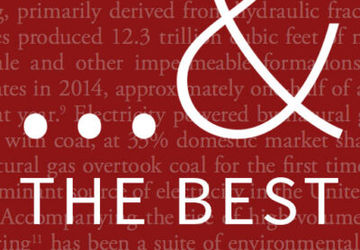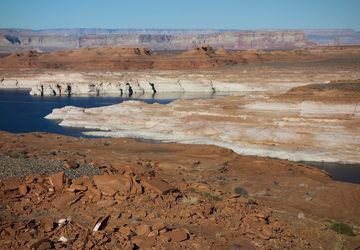In Santa Fe, Center Convenes Innovative Leaders to Tackle Rural Issues

SANTA FE, N.M. – The rural western United States has long symbolized a rugged individualism, a simple, rewarding lifestyle against the backdrop of some of the most beautiful scenery America has to offer. But that lifestyle and beautiful scenery are being threatened by economic, social and environmental forces that are growing in intensity, according to experts gathered at a conference here co-sponsored by Stanford’s Bill Lane Center for the American West last week. If left unchecked, these forces could decimate a part of the country home to millions of Americans and forever change the country’s landscape.
Watch the Complete Sessions
Complete video of the conference keynotes and sessions is now available at the Rural West Conference website.
What’s alarming about the state of the rural West is that it hasn’t changed much in more than a century.
In 1908, President Theodore Roosevelt created the Commission on Country Life to learn more about rural lifestyles and help those residents keep up with an emerging America as the 20th century began. The next year, the U.S. government issued the Report of the Country Life Commission, which reported a list of deficiencies that motivated Americans to head for urban areas. Some of those deficiencies were unemployment, under-resourced schools, economic insecurity, inadequate infrastructure and poor health care.
“Many of those deficiencies persist today, and a century later we haven’t adequately addressed those issues,” David Kennedy, the Donald J. McLachlan Professor of History, Emeritus, said at the conference.
The rural West “is a lonely place to be,” he said. In addition to problems that plague rural citizens all over the U.S. – such as poverty and dealing with chronic diseases like diabetes at significantly higher rates than urban Americans – the circumstances of rural westerners are further worsened because of their extreme distance from urban centers, which can provide vital services such as health care.
“If you’re in rural western America, you’re more lonely than you are in rural Kentucky or rural Florida,” Kennedy said.
Escaping from this troublesome circumstance is even more difficult because the West is missing what Kennedy calls “economic dynamism.” Although more than 2,000 of the United States’ 3,011 counties are categorized as rural, Kennedy said, those counties account for just over one-third of the nation’s gross domestic product. Without viable economic opportunities, rural citizens struggle to keep pace in an economy that is leaving them behind, and that lack of economic dynamism, “has cascading effects in the realm of medical care and health care access,” Kennedy said.
“We are revisiting an issue that was first identified well over 100 years ago,” Kennedy continued. “We’ve made some progress on the set of issues that the Report of the Country Life Commission identified, but not enough.”
Focus on health
The multitude of problems facing the rural West are so intertwined it can be difficult to pinpoint where to begin addressing this crisis.
The 5th Annual Eccles Family Rural West Conference, sponsored by the Lane Center and the Spencer F. and Cleone P. Eccles Family Foundation, focused on health, which has deteriorated among millions in our western states.
Obesity, chronic illnesses and a surge of opioid use has plunged the rural West into a dangerous circumstance. Adding to those issues is the lack of quality, accessible health care. Approximately one-fourth of U.S. residents live in rural areas, yet only about 10 percent of the nation’s physicians serve those communities. Transportation issues and the high cost of health care can serve as even more of a deterrent for rural Americans to seek care.
In a stroke of serendipity, Friday’s discussion at Santa Fe’s School for Advanced Research coincided with a proposed vote by the U.S. House of Representatives to repeal and replace the Affordable Care Act (ultimately, the measure was not brought to the House for a vote).
With the likelihood that the ACA will remain intact for some time, panelists offered their thoughts on how to improve health care – for rural and urban Americans alike.
“I think the biggest change that needs to happen in health care to make it affordable and to allow us who live in this country to live healthier and more productive lives is to change the incentive system,” said Charles Sorenson, the former president and chief executive officer of Intermountain Healthcare, a not-for-profit health system based in Salt Lake City, Utah. “The fee-for-service incentive system in my view is the chief inhibitor of doing the right things for our populations.”
Sorenson also touched on a major theme throughout the conference of “upstream vs. downstream” – focusing on preventive care (upstream) instead of addressing health when it has deteriorated into chronic ailments (downstream).
“We pay health systems enormous amounts of money to fix bad problems like cancer and vascular disease,” Sorenson continued, “but we don’t reward people for prevention in this country.”
While policymakers have worked for years to improve health care, Gabriel Garcia, a professor of medicine and associate dean for medical school admissions at Stanford’s School of Medicine, supports an approach that rural communities could readily apply.
“I think that solutions are likely to be coming from people who focus on health, not health care,” said Garcia, who described a San Mateo, California, community’s successful transition to a reliance on “promotoras,” or community health workers. “These kinds of community partnerships, looking at solving local problems locally and thinking about health before health care, is I think the way we’re going to go.”
Stanford’s role

The Lane Center was created, in part, to help find solutions for these complex problems, and the Eccles Conference has been an innovative setting for leaders in academia, government, health care, the nonprofit arena and the private sector. According to Bruce Cain, Lane Center director and professor of political science, the center has served as a “convener,” rallying stakeholders to identify problems and share research findings. The center has previously hosted this conference in California, Montana, Oregon and Utah, partnering with universities and professionals in those areas.
Those events have produced a trove of valuable data and recommendations that, with the appropriate support, could translate into meaningful action.
“There’s an importance of getting people’s attention to the problem,” said Cain, who is the Charles Louis Ducommun Professor in Humanities and Sciences. “That’s going to be important in terms of getting public opinion support, important in getting stakeholders involved.”
The Bill Lane Center’s external reach has been critical to bringing attention to the rural West’s plight, but the interdisciplinary bridges the center has built within the Stanford community have been just as vital. The Lane Center has teamed with schools, centers, institutes and programs in journalism, energy, economics, and environment and sustainability, among others, to address pressing issues such as the West’s growing water crisis with its Water in the West initiative. Enhancing those existing relationships while forming new, interdisciplinary connections are vitally important, Cain said.

“We need to strengthen our partnerships,” Cain said. “Starting where our strengths are, which as a university tends to be expertise and a convening capacity, then building with the partners we know best.”
Building on Momentum
While the challenges facing the rural West are daunting, attendees left the conference optimistic as organizers put forth action items to build off its momentum, notably connecting with local communities to learn their most pressing issues, continued and enhanced collaboration with partners and a concerted effort to engage Stanford entities in the center’s Rural West Initiative.
“Our hope is this is the start of working toward a healthier rural West,” said Phil Polakoff, a consulting professor of medicine at Stanford, who played a critical role in the program design of the conference. “It’s not going to happen overnight. This has to be a major collective effort.
“Hopefully, we can take the experience over the last two days and not say that this is the conclusion for today, but the start for tomorrow.”


